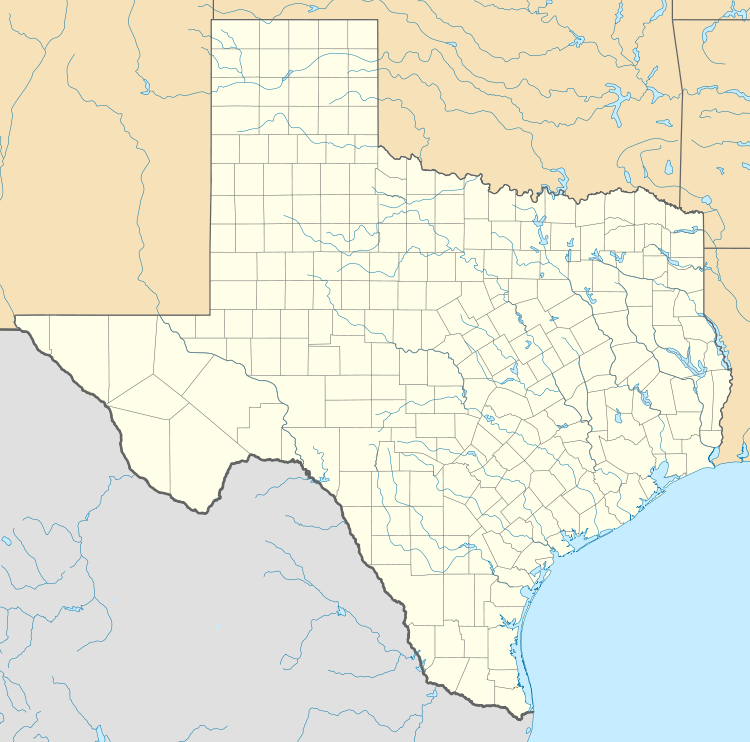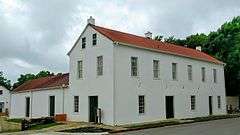Landmark Inn State Historic Site
|
Landmark Inn State Historic Site | |
|
The Landmark Inn in 2016 | |
  | |
| Location |
Florella and Florence Sts, Castroville, Texas, USA |
|---|---|
| Nearest city | Castroville |
| Coordinates | 29°21′18″N 98°52′29″W / 29.35500°N 98.87472°WCoordinates: 29°21′18″N 98°52′29″W / 29.35500°N 98.87472°W |
| Area | 5 acres (2.0 ha) |
| Built | 1849 to 1870s |
| Built by | Monod, Caesar; Vance, John |
| NRHP Reference # | 72001368[1] |
| RTHL # | 3031 |
| TSAL # | 470 |
| Significant dates | |
| Added to NRHP | January 7, 1972 |
| Designated RTHL | 1965 |
| Designated TSAL | 6/28/1983 |
The Landmark Inn State Historic Site is a historic inn in Castroville, Texas, United States. It serves the general public as both a state historic site and a fully functioning bed & breakfast with seven overnight rooms.
Cesar Monod, a Swiss immigrant, arrived in Indianola, Texas in the 1830s[2] and settled in Castroville, Texas above a busy crossing at the Medina River in 1849. There he constructed a one-story limestone building that he used as a residence and a general store. In 1850, he added a second lot that included a small house built by Alsatian immigrant Michel Simon in 1847.
John Vance purchased Monod's property in 1853 and added an ell wing to the general store to better serve travelers on the Old San Antonio Road that passed through Castroville on the way west to Eagle Pass, El Paso, and points beyond. In 1859, Vance added a personal residence, which was the largest in Castroville at the time, and converted Simon's small house into a wash house for use in both bathing and clothes washing. As the town grew and traffic on the road increased after the Civil War, Vance added a second story to the store building in 1874 to provide rooms for overnight guests.
In 1854, Vance sold the riverfront portion of his property to George L. Haass and Laurent Quintle, who built a dam on the river and constructed a water powered grist mill to process grain and gin cotton for local farmers. Joseph Courand, an immigrant to Texas from Alsace, bought the mill in 1876 and made substantial improvements to it before his death three years later. When Joseph Courand, Jr., took over from his father, the mill was processing lumber, cotton, wheat,and over a million bushels of corn per year starting in the 1880s. The mill was the industrial center of Castroville until the 1920s.[3]
Courand bought the Vance property in 1899 and converted the 1859 Vance residence into a warehouse. The Vance Hotel was rented from time to time but was otherwise not maintained as it had been in the past. Courand and his family moved to San Antonio in 1903 but continued to manage the property and a separate general store on the town square in Castroville.
As milling business declined in the early 1920s, Courand posted the entire property for sale. Jordan T. Lawler bought the it 1925 and converted the mill to a hydroelectric plant to provide Castroville with electricity for the first time. He and his sister, Ruth C. Lawler, made the first floor of the old Vance Hotel their home and rented rooms upstairs and in the old Vance House. The historic hotel was officially re-opened as the Landmark Inn on July 4, 1942. Ruth Lawler had the property designated a Recorded Texas Historic Landmark in 1965 and added to the National Register of Historic Places in 1972.
State Historic Site
In 1974, the property was donated to the Texas Parks and Wildlife Department (TPWD), which conducted extensive archaeological investigations[4] and made significant repairs and improvements before opening the property to the public as a state historic site on October 25, 1981. TPWD also had the property designated as a Texas State Antiquities Landmark in 1983. On January 1, 2008, the site was transferred from TPWD to the Texas Historical Commission, which completed a two-year renovation and historic preservation project in December 2015. Tours, programs, and special events are offered regularly for visitors to the site. A new museum exhibit is in development and is planned to be installed in October 2016.
Bed and Breakfast
In addition to serving as a state historic site, the Landmark Inn is also a fully functioning bed and breakfast with seven rooms that are available for overnight stays. The guest rooms are furnished with antiques and historical reproductions that are sympathetic to the either the mid-1800s, late-1800s, or early twentieth century, depending on the room. While the rooms have furnishings that reinforce the historical interpretation of the site, they also have modern conveniences, such as electricity, indoor plumbing, and climate control systems. Televisions and radios are not provided but free Wifi is available.
See also
References
- ↑ National Park Service (2010-07-09). "National Register Information System". National Register of Historic Places. National Park Service.
- ↑ Wolff, Linda. Indianola and Matagorda Island 1837-1887. Eakin Press, Austin, Texas, 1999.
- ↑ Parent, Laurence. Official Guide to Texas State Parks. University of Texas Press, Austin, Fourth printing, 2005.
- ↑ Parsons, Mark (1984). Landmark Inn Archaeological Investigations. Austin, Texas: Texas Parks and Wildlife Department.
External links
| Wikimedia Commons has media related to Landmark Inn State Historic Site. |
